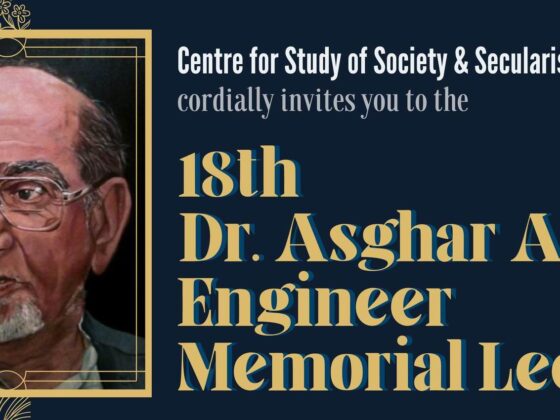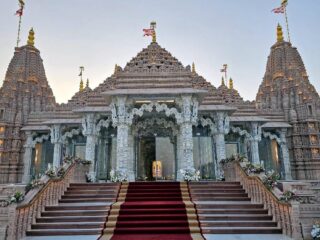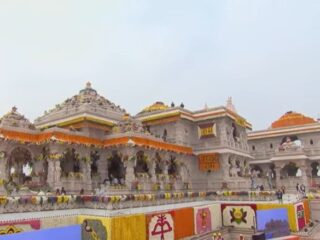Irfan Engineer and Neha Dabhade
(Secular Perspective September 16-30, 2021)
Recently, a separate room for Namaz was allocated in the Jharkhand Assembly which was bitterly protested against. BJP MLAs opposing this move chanted Hanuman Chalisa and “Hare Rama” at the entrance of the Assembly. They stepped into the Well, shouting “Jai Shri Ram” slogans. This incident offers a glimpse into how public spaces have turned into an arena for competitive manifestation of religiositymotivated more by demonstrating prowess of one’s community rather than faith in righteous path prescribed by religion. Communalism has always been about loyalty to one’s community and its political, economic,social, and cultural interests rather than submission to God. The Constitution of India guarantees freedom of religion and thereby grant all individuals the liberty to freely practice, propagate and profess their religion. However, it also lays down limitation to the freedom of religion as competitive, unbridled and excessive manifestation of religion may threaten fundamental rights of other citizens; may disturb public order as we witness during riots or religious processions; pose danger to public health, as we witnessed during the Covid pandemic by assembly of Tablighi Jamaat at Markaz and Kumbh Mela and other religious assemblies;and morality. To ensure peace and communal harmony, the state must be a neutral arbitrator in determining minimal limits to freedom of religion for maximum freedom, and limits must be fair, reasonable and proportionate to the problem at hand.However, we know from our experience that the state is neither fair, nor a neutral arbitrator and that triggers off competitive assertion of religiosity as we witnessed in the case Jharkhand and try to capture the state, outmanoeuvring the rival community. For instance, instead of calling the allocated room for namaaz, the administrators could have simply called it a prayer room for all legislators to pray in their own religious traditions. It is possible that the prayer room would have been visited rarely, or even remained unvisited by legislators of all faiths. For the competition of religiosity, faith is of least importance. Mobilizing the community and strengthening community bonds for larger share in socio-cultural and public space takes precedence over faith. Suffering of cows in gaushalas run by fellows from community is a non-issue but a Muslim transporting a cow or driving a vehicle which becomes a provocative issue. Recitation of Hanuman Chalisa and slogan of “Jai Shri Ram” is used not out of faith and devotion of Lord Ram or Hanuman, but as a war cry against the rival community and to show prowess. For the same reason, it is debateable whether the political leaders of the Muslim community demanded prayer room for namaaz out of genuine faith or to show to their community members, whose votes they desire, their prowess and influence with the state. Similarly, if the state is subsidising Haj pilgrimage, it should spend even greater amount on Hindu pilgrimages, festivities and rituals. If Hindu family laws were enacted and codified, why aren’t Muslim family laws left untouched? Sense of grievances and injustice, victimhood, irrational fear of the ‘rival’ are some of the tools that community elite deploy to mobilize the community and bond together for purely secular interests and outcomes. Ridiculing the rival community in the game of competitive rivalry and spreading prejudices are other tools. Grievance of injustice and victimhood on one hand, and irrational fear of the rival on the other hand has gripped a large section of people, particularly in northern and western India and hence Indians are being reduced more and more as camp followers of community elite rather than as rational citizens having rights, duties and ideas for good policies and better development.
Secularism on the other hand offers a model of peaceful co-existence, allowing citizens to follow whichever religion they may choose in private and collectively, but without causing any inconvenience to others and the state being a neutral arbitrator, not defined or patronized by and not subscribing to any religion. Mahatma Gandhi offered maximalist goal of ‘sarva dharma samabhav’ i.e., citizens having equal respect for all religions and consequently, the state too treating all religions likewise. Jawaharlal Nehru, on the other hand strived to inculcate respect for diversity and seeking unity in diversity. Unity of vision for development, and to defend India. However, communities – religious, linguistic, cultural, would have space for themselves.Before we discuss a range of manifestations of religions across different communities in India and the varying state response to them, it will be helpful to look at what the boundaries the Constitution draws. Articles 25 to 28 guarantees freedom of religion. Article 25 (1) guarantees to every person the freedom of conscience and the right to profess, practice and propagate religion- subject to public order, morality, health and fundamental rights of the citizens. Article 26 grants rights to religious denominations to manage their affairs, establish palaces of worship, to acquire immovable properties necessary for religious institutions and undertake charities. Article 27 provides freedom from payment of taxes for promotion of any particular religion and finally Article 28 prohibits religious instructions in educational institutions. The Indian state, unlike secularism practiced in other countries, has an additional mandate under Article 25 (2) (b) of the Constitution to interfere in religious practices – to promote social reforms within the Hindu community because caste hierarchies and in order to abolish “untouchability”.The import of these provisions becomes clear when we understand what secularism in India means. Rajeev Bhargava, the celebrated political scientist recommends that the Indianstate should follow the doctrine of “principled distance” from all religions – distance based on principles to promote equality rather than equal distance as all religions have their specifities, peculiarities and uniqueness. It also means state can intervene to initiate reforms if required and not be a silent spectator to injustice.
Though the Constitution and doctrine of secularism adopted in India espouses freedom of religion, subject to the limitations, or reasonable restrictions as outlined above, and the state is not supposed to favourany religion, competitive religiosity is questioning utility of secularism. The communal leaders of the majority community feel that the equality principle of secularism leads to injustice on the majority community as they should have greater share in the collective resources of the nation and on common public spaces. The minority communities, according to them, should have only such a reduced share as the majority community is willing to afford, and there would be peace only if the distribution afforded by the majority community is accepted by the minority communities. This includes allowing majority community to steal the flocks from minority community via “gharwapsi”, the minority communities would not have similar freedom augment themselves demographically via religious conversion, or inter-religious marriages. Anything short of these privileges, they plead victimhood and reject secularism along with its principle of equality. The leaders of minority community, on the other hand seek equal protection of state under the doctrine of secularism to practice their religion and scream violation of secularism whenever the state enforces limitations on manifestation of their religion, whether reasonable and fair or otherwise. For instance, the Muslim communal leaders resist any attempt codify their family laws even to ensure gender justice within the framework of Quranic jurisprudence. The way public spaces are increasingly being permeated by religious festivals, practices, customs and traditions; the constitutional mandate stands neglected for all practical purposes. Though there can be no compromise on the freedom of religion- a right important to any society especially a pluralistic society, there cannot and should not be appropriation of public spaces for communal mobilization, communal assertion and subsequently competitive communalism. How does one strike a balance?
First, the mandate of a reformist state is wide enough to reform the religion beyond recognition. While manifestation of religion is subject to limitations, the state mandate to reform religion is not! The judiciary stepped in fill up the vacuum. In its various watershed judgmentsthey have made a fine distinction between what is essential and integral to religion and must be left untouched and not interfered with. It can be understood as such:“[I]t may not be out of place incidentally to strike a note of caution and observe that in order that the practices in question should be treated as a part of religion they must be regarded by the said religion as its essential and integral part; otherwise even purely secular practices which are not an essential or an integral part of religion are apt to be clothed with a religious form and may make a claim for being treated as religious practices within the meaning of Art. 26. Similarly, even practices though religious may have sprung from merely superstitious beliefs and may in that sense be extraneous and unessential accretions to religion itself. Unless such practices are found to constitute an essential and integral part of a religion their claim for the protection under Art. 26 may have to be carefully scrutinised; in other words, the protection must be confined to such religious practices as are an essential and an integral part of it and no other.’ (The Durgah Committee 1961:412). This principle of essential practice can be a litmus test allowing or disallowing manifestation of religion though ideally religion should be a private affair and no religion should be privileged over the other. This doctrine of essential practices comes with its own set of problems, primary being who decides what constitutes an essential practice in a religion? Can the judiciary decide what is essential practice with legal knowledge? Will that legal knowledge be sufficient to determine what is essential to a religion? Alternatively, the judiciary can refer to Holy Scriptures to determine what is essential practice? However, is it always possible especially when some religions like Hindu religion has no one Holy Book? Also religion is not static but evolves when it interacts with other religions, faiths and cultures- its practices and customs become syncretic in nature as a result of this interaction. Moreover, is everything in the Holy Scriptures relevant today and always just to women, Dalits or poor? Keeping these complexities in mind, it is best if the communities decide what is essential. Again there is a risk here that communities too have hierarchies and may not come to a consensus. These complications further point to the necessity of evolving a sound framework to decide which religious practices must be subjected to limitations.
If seen in the light of the above, is it necessary to have a namaz room in the Assembly? The answer would be no. Though offering namaz is integral to Islam religion; it can be offered anywhere, even without a separate room. Also followers who miss a namaz or prayer can offer an additional prayer later. Alternatively, the legislators can excuse themselves from the assembly to offer prayers if they so wish to anywhere in the neighbourhood. But to have a room allocated for offering namaz in the assembly- symbolically one of the most secular spaces and also where laws are made should be devoid of such religious practices or privileging any particular faith. At the same time, the reciting of Hanuman Chalisa, which incidentally is not even an essential practice to Hindu religion, should be condemned equally. The recital was an act of competitive assertion of identity.This in no way takes away from some of the unreasonable practices carried out by the Muslim community which will fall into the limitations set by the Constitution that of public order, health, morality and fundamental rights of other citizens. For instance, the demand for retaining the practice of triple talaq is against the fundamental rights of women and morality. Unregulated animal sacrifice, particularly in shared common spaces on the occasion of Eid-ul-Adha may leave the non-Muslim (or even Muslim) neighbours uncomfortable and maybe offensive to public morality or even public health. Similarly, the demand of not playing music or loudspeakers in front of the Mosques during religious processions of other communities might violate someone else’s fundamental right. There has been violence when the Muslims and the Hindus have insisted on having same routes at the same time for their respective processions.
The above instances have led to criticism and demand of regulation. The framework for manifestation of religion in such cases should have some principles- namely, they should be fair and reasonable, just, non-discriminatory and proportionate to the problem at hand. It is no secret that some festivals or traditions associated with Hindu religion are being patronized and promoted utilizing state resources by the current ruling regime. At the same time, some practices of the Muslim community have come under flak and criticism. Some of the examples of this is usage of loudspeakers for Azaans and offering namaz on roads or open public spaces. While these are valid criticism and no citizens should be inconvenienced in any way, the same standard should apply to all religious practices. For instance, the processions undertaken by Kanwariyas have led to eruption of communal violence and blockades of roads. Thousands of kanwariyas, devotees of Lord Shiva with pots of holy water undertake procession on foot across North India every year. There have been some recorded instances of hooliganism and chaos during these processions leading to shut down of the highways. Some politically motivated communal leaders accompany the processioncarrying weapons and loudspeakers riding aggressively ontheir motorcycles. The police instead of taking strict action against the miscreants have showered flower petals on the procession from helicopters- a clear sign of state patronage and “normalizing” such procession as “Indian culture”.
Another festival that is increasingly occupying the public spaces and,in some cases used for political mobilization and polarization is Ram Navami. Ram Navami processions in the recent years have witnessed communal tensions, even claiming innocent lives including that of Sibtulla Rashidi a teenager in Asansol town of West Bengal. This religious procession is increasingly becoming a pretext to force communal polarisation in many states. Politically motivated communal leaders in these processions, carry swords and tridents, with a political intent of polarization along religious lines by aggressively chanting derogatory slogans against the Muslims and claiming superiority of the Hindus. These processions have triggered riots in Asansol, Raniganj and Burdhaman in West Bengal and Bhagalpur in Bihar in 2018 alone, drawing new fault lines. Swords, tridents and Ram Mandir constituted the dominant iconography in these processions- more of political symbols than religious. The religious cover of such political intents must be taken off and politically motivated elements should be identified and brought to justice.
Other instances of state patronage to religious manifestations are the organizing of Kumbh melas by the ruling regime. In 2019 alone, INR 4200 crores were earmarked for the Kumbh Mela in Uttar Pradesh. This was couples with 221 meters tall statue of Ram, costing over 400 crores. Quite appallingly, the Kumbh Mela was organized in Uttarakhand in April 2021 during a raging Covid pandemic when the pandemic was claiming thousands of lives, apart from INR 325 crores sanctioned for the organization of the mela. Are these melas integral to the religion and should the state in a secular democracy facilitate such melas even in times of deadly pandemics?
It is evident that there is a marked shift or clear disregard to any regulation or restraint on religious manifestations in public spaces at least when it comes to Hindu religion. The manifestations of Hindu religion are much less subjected to limitations even when they pose a threat to public order or public health. This process sometimes is subtle and other times blatant but with the same result- normalizing these manifestations as normal. Some examples of this can be cited in Universities. Most colleges and universities have satyanarayan pujas. Though article 27 of the Constitution prevents a person from being compelled to pay any taxes which are meant for the payment of the costs incurred for the promotion of any religion or religious denomination, by performing pujas worshipping Hindu gods and goddesses, there is an attempt to normalize the narrative that such traditions are “normal” culture. This holds true for temples of Hindu Gods in many police stations across the country. We are all aware how temples, Dargahs and other shrines have proliferated in the most mundane space (even under ordinary trees!), starting from laying down a ubiquitous ordinary stone which is worshipped to making a small cover over it. Eventually it is expanded and a grand structure is built over and around it to be called a temple or Dargah. These structures become so sacrosanct that they can’t be moved or touched given the sentimental and emotional value attached to it. This mushrooming of illegal structures has become a commonplace phenomenon.
The above examples help us understand how public spaces have become arenas of competitive self-assertion. The dominant ideology given its tremendous power and resources to influence and shape the dominant narrative is pushing its political agenda through such manifestations of religion in public. It doesn’t come as a surprise then that Muslims are accused for different forms of Jihads- love and narcotics! In Kerala, the Muslim community is now accused of getting non-Muslims addicted to drugs from different public spaces. This will lead to increasing alienation of minorities from public spaces owing to the meta-narrative that manifestation of majority religion is the normal and thus not contested. This trend and discourse is alarming given the precedent it sets and is another step towards majoritarianism. Thus there is a need to evolve a framework which treads on the principle of Constitution and can reclaim public spaces impartially. Religious tradition and manifestations of all religions without fear and favour have to be restricted in public spaces in accordance to the limitations put down by the Constitution to protect the essence of a secular state.






